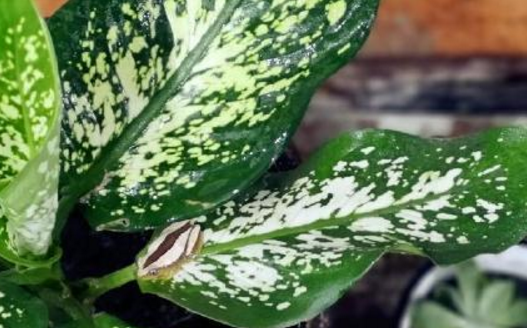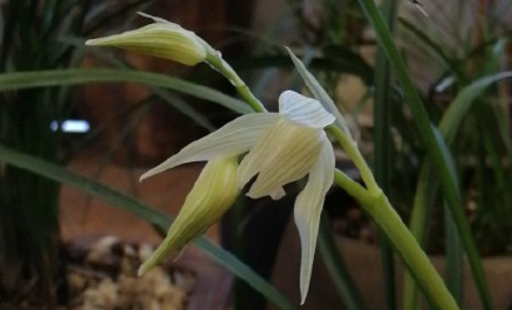What is the difference between Cymbidium and Cymbidium? How to maintain it? Planting common problems and solutions?
Cymbidium can be planted in most areas south of the Yangtze River, mainly in Yunnan, so what is the difference between Cymbidium and Cymbidium? How to maintain it? Planting common problems and solutions? According to the data, Douban orchid is not picky about the growth environment, whether it is warm indoor, or in hillsides, valleys, ravines and so on. The choice of soil is not strict, and it can grow on red soil, podzolic soil and humus soil. The suitable temperature span for growth is 15ml and 35 degrees, and the flowering period is from December to March of the following year.

What is the difference between Douban orchid and spring orchid?
1. The difference of plant shape between Cymbidium and Cymbidium.
The pea orchid plant type is semi-drooping, not stiff, the leaf foot is more scattered, and the petiole is mostly shallow u-shaped, which appears to be "soft if boneless", which has a kind of soft beauty; the joint between the petiole and the root of the cymbidium is strong and powerful, with an obvious waist, compared with the stiff one.
2. The difference between the leaves of Cymbidium and Cymbidium.
The leaf of Cymbidium is narrower than that of Cymbidium, the leaf shape is long and narrow, there is no petiole ring, the vein is obvious, and it is found that the vein is transparent to the sun. The leaves of Cymbidium are relatively wide, the leaves of Cymbidium are rough, and the leaves of Cymbidium feel smooth. The left side of the picture below is the leaf of Douban orchid, and the picture on the right is the leaf of Chunlan.
3. The difference between the roots of Cymbidium and Cymbidium.
The root system of Cymbidium is hypertrophic, the corm is not obvious, but the root tip is obvious, the plant bud is relatively fat before unearthed, the glossiness is weak, and the pseudo-scale bulbs are mostly arranged in one word; at the junction of the roots and leaves of Chunlan, there is an inconspicuous pseudo-corm, and most of the false scale balls are dislocated, which are sharp and glossy before being unearthed.
4. The difference of flowering between Cymbidium and Cymbidium.
Bean orchid has a single flower in spring and its petals are thick. except for a few orchids with fragrance, they are generally fragrant and have more single flowers. Chunlan has many flowers in one arrow, mostly with 2-4 flowers, the fragrance of the flowers is more obvious, and most of them are distinguished by the scent of flowers in the market.
Second, how to maintain it?
1. Water supply of Douban orchid
Bean orchid water resistance is general, so in the maintenance process can not be too much watering, not stagnant water, when the soil surface is dry, pour a small amount of water to moisten the basin. Generally run the basin every other day in summer, water thoroughly twice a month, and twice a week in autumn, once a month. Proper amount of water control in winter can moisturize the basin once a week.
2. Light management of Douban orchid.
The growth of Magnolia needs long light cycle, proper shading in summer and autumn, and no shading in winter and spring. Lack of light may make it difficult for bean orchids to blossom, so pull them out to bask in the sun.
3. Temperature and humidity control of Douban orchid.
Bean orchid likes to be warm in winter and cool in summer, and the optimum growth temperature is 15-28 ℃. The temperature in spring and autumn does not need too much attention. The temperature in summer grows slowly when the temperature exceeds 35 ℃. It can be cooled by shading and spraying. The temperature below 10 ℃ in winter should be moved into the room to prevent frostbite. The suitable air humidity is 70-80%, and the suitable humidity in winter is 50-60%.
4. Fertilization measures of Douban orchid.
The cultivation medium of Douban orchid is rich in nutrition, so there is no need to apply chemical fertilizer in the process of cultivation. Mixing appropriate amount of cake fertilizer or sheep manure in the process of changing pot or soil once a year can provide sufficient nutrition for Douban orchid. Generally, no fertilizer is applied in the middle.
5. Ventilation management of Douban orchid
In a well-ventilated environment, Douban orchid promotes the respiration of orchid plants, accelerates metabolism and promotes growth; if the ventilation condition is poor, it is easy to cause a large number of bacteria and mold to multiply, bringing rot and mold is not conducive to the growth of orchids. The choice of ventilation places should fully take into account the wind, to avoid strong winds, cold wind damage leaves.
Third, common problems and solutions in planting?
1. Bean pea orchid fried tip
The reason for the burning of bean orchid
The leaf tip of bean orchid is light white or light brown, mostly due to improper watering (too dry or negligent), water temperature and room temperature are also important influencing factors; if the leaf tip is black, it may be due to excessive fertilization and high concentration, resulting in burning tip.
The solution to the burning point of bean orchid
When watering, you should pay attention to standing the water at least one night in advance to ensure that the chlorine in the water is volatilized cleanly, and you can also bask in the scattered light for 3 hours. On the one hand, the water temperature is low, on the other hand, the bleach and fungicides in the water are difficult to metabolize after being absorbed by plants; in the process of watering, you should pay attention to keeping the soil surface moist, not too much watering, of course, not too dry.
If the burning tip caused by too much fertilization, then you should soak the basin as soon as possible, and change the water many times to wash off part of the excess fertilizer in the soil.
2. Inverted seedlings of Cymbidium
The reason for the fall of seedlings of Cymbidium
When watering, water accumulates in the center of the seedling, and under direct sunlight, the water evaporates too quickly to take away the water on the plant, causing dehydration and even burning spots; old and diseased seedlings will also cause seedling collapse.
The solution of inverted seedlings of Cymbidium formosana
Water should be watered gently along the basin to avoid damaging the roots on the soil surface or splashing water on the leaves. If the water has been splashed on the leaves, you can first put the flowers in the shade and wait for the water to evaporate before placing them in the sun.
Old seedlings and diseased seedlings should be cleaned in time, and hands should be washed in time after touching diseased seedlings to prevent germs from infecting more plants.
3. Stiff seedlings of Cymbidium
Causes of stiff seedlings of Cymbidium chinense
Too high or too low water temperature or room temperature can cause stiff seedlings.
The solution to the stiff seedling of soybean orchid
Pay attention to control the water temperature, you can first dry some water as a preparation for watering flowers.
The flowers can be slightly shaded in summer, and can be moved indoors in winter, or put on a simple plastic shed to keep warm.
Time: 2019-03-16 Click:
- Prev

What is the hydroponic culture method of evergreen in Araceae? What if the leaves are soft? How do you breed?
Evergreen (scientific name: DieffenbachiapictaLodd.) is also known as Dai Fan Ye, so what is the hydroponic culture method of evergreen? What if the leaves are soft? How do you breed? According to the data, evergreen is a plant native to South America and Brazil.
- Next

Is the lotus petal orchid belongs to the big snow element culture method and matters needing attention? What if the leaves turn yellow? What's the difference between Chunlan and Chunlan?
Da Xue Su, commonly known as Da Suxin, also known as New Year's Day, because of its wide leaves, also known as wide leaf Suxin, so the breeding methods and points for attention of Da Xue Su? What if the leaves turn yellow? What's the difference between Chunlan and Chunlan? According to the data, Da Xue Su likes a warm and humid environment, with no severe cold in winter and no heat in summer.
Related
- Fuxing push coffee new agricultural production and marketing class: lack of small-scale processing plants
- Jujube rice field leisure farm deep ploughing Yilan for five years to create a space for organic food and play
- Nongyu Farm-A trial of organic papaya for brave women with advanced technology
- Four points for attention in the prevention and control of diseases and insect pests of edible fungi
- How to add nutrient solution to Edible Fungi
- Is there any good way to control edible fungus mites?
- Open Inoculation Technology of Edible Fungi
- Is there any clever way to use fertilizer for edible fungus in winter?
- What agents are used to kill the pathogens of edible fungi in the mushroom shed?
- Rapid drying of Edible Fungi

